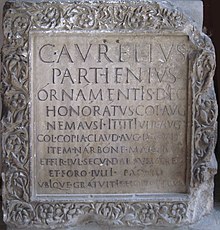Long I

Long i, ⟨ꟾ⟩, transcribes a long i-vowel /iː/ in Latin. It stands in for the apex used on other the long vowels: ⟨á é ó v́⟩ /aː eː oː uː/. An example is LV́CIꟾ·A·FꟾLIꟾ, which in modern rendition would be lūciī a fīliī, with a macron rather than apex to indicate vowel length.
See also
External links
- Davud J. Perry (2006-08-01). "Proposal to Add Additional Ancient Roman Characters to UCS" (PDF). Retrieved 2018-09-30.
